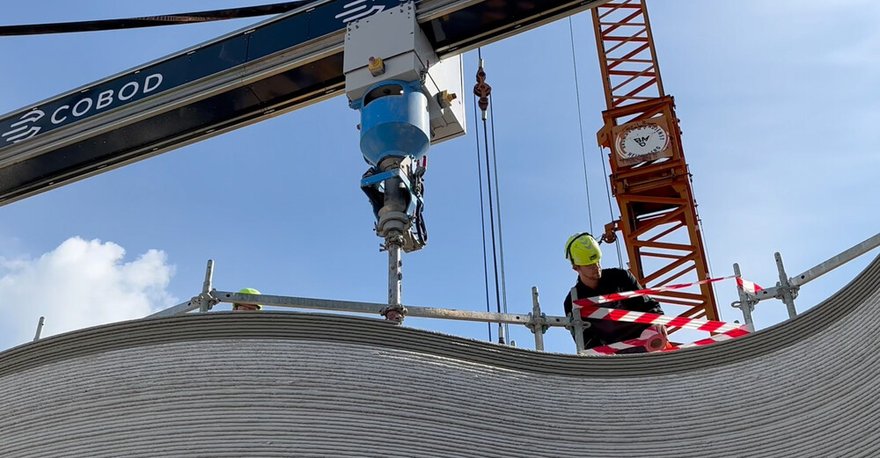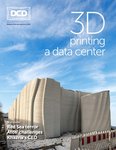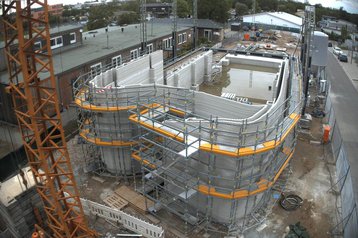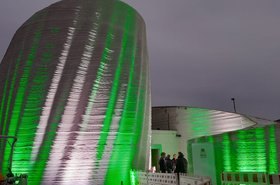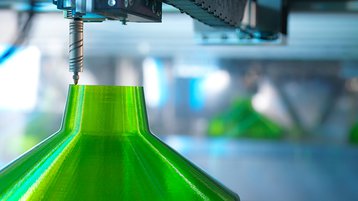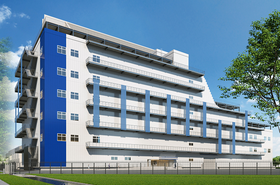While many will no doubt know 3D printers can be used to make small plastic objects that are useful for rapid prototyping, the technology is increasingly being used on a much larger, more permanent scale.
In construction, industrial-grade 3D printers can be used to extrude layer after layer of construction, building concrete walls quickly and accurately with minimal human input.
Dozens of small residential buildings are now being printed rather than built. But with the recent development of the world's first 3D printed data center in Germany, is the technology ready for prime time in the industrial market?
Why 3D print?
3D printing concrete is said to have originated out of the Rensselaer Polytechnic Institute (RPI) in New York when Joseph Pegna applied additive manufacturing to concrete in 1997.
Then Behrokh Khoshnevis, a professor at the University of Southern California, 3D printed an entire wall in 2004. The first 3D-printed house was built in 2014 in Amsterdam, the Netherlands.
Market reports suggest the global market size of the 3D printing construction industry was $3.5 billion in 2022, and is estimated to grow to around $523.3 billion by 2030. To date, however, most printing construction has been in the residential market.
In 2018 Icon and New Story printed a 350 sq ft (32.5 sqm) home in Austin, Texas, in around 48 hours. The company said it was able to build a home for just $10,000, sparking a wave of interest from developers – though that number was only for the concrete walls rather than the full build-out.
“That really started the fire underneath this whole thing,” says Ziyou Xu, founder of California 3D printer provider RIC Technology (previously Advanced Intelligent Construction Technology). “And then in the last couple of years, buildings have been permitted in North America, and that's a big step. People are starting to buy in and believe in 3D printing.”
“This has grown interest from novelists and experts and universities to bold developers. we're past the novelty phase; construction companies are now coming in and wanting to try this and figure out how to make this profitable and efficient.”
Advocates tout speed and cost as major benefits, while also reducing the number of workers required on-site. Many 3D builds only need two or three people to manage a printer. Xu says 3D printing also ensures constructed buildings are closer to the original designs created by the project architects and site owners.
“I've always looked at things from an architect's standpoint, and each project takes a huge amount of communication, effort, and compromise,” he says. “And the end result is never what the architect really wants, which is what the owner or developer wants.”
“With 3D printing, we are actually taking out a lot of the communication costs and inefficiency out. And the end result will be much more in line with the design that the developers or the owners want.”
3D printing comes to residential
Most 3D printing construction firms are either startups or subsidiaries of larger construction firms interested in exploring the technology. Founded in 1969, German scaffolding firm Peri began looking at 3D printing in construction and what it could mean for the company. It invested in Cobod in 2018, taking a minority stake in the Danish firm, and officially launched Peri3D in 2022. Today Peri3D sells 3D printers and services, and prints its own buildings.
After being involved in Germany’s first 3D printed home – a two-story family house in Bekum – in 2020, Peri has been involved in a multi-story, five-family apartment building in Wallenhausen and a gateway sculpture in Dornstadt, Germany; a 125 sqm office building in Hausleiten, Austria; and a single-family home in Tempe, Arizona.
Today, the quantity of 3D-printed buildings is probably in the low hundreds. Printers have been used on houses in Belgium, South Africa, New Zealand, Russia, France, and more, as well as bridges and wind turbine prototypes.
Icon has been used to print a ‘vehicle hide structure’ – essentially a garage – at Camp Pendleton in California, and says it has printed more than 100 homes. CyBe created a 3D-printed R&D lab for drone research in the UAE.
RIC’s Xu notes Accessory Dwelling Units (ADUs – small secondary buildings on residential plots and also known as backyard cottages, granny flats, or laneway houses) are a potential area of growth for 3D printing.
He says the lower cost of entry into the residential market and printer limitations means that’s where most of the interest around 3D printing construction is currently focused.
The Wavehouse in Germany is the first time a developer has been willing to take on the cost and risk of a commercial industrial building; and the first time a data center has been 3D printed.
On the industrial side in future, Xu notes there’s promise around warehouses and cold storage facilities, and he has been approached by a number of prison development organizations due to the potential wall strength of 3D printed projects.
A new skill to address a labor shortage
The Wavehouse reportedly only required two construction workers while the printer was in operation. Other 3D printing construction projects report similarly small numbers of staff on-site.
This reduction in labor is being heralded as some as a way to help address skills shortages in the construction industry. In the UK alone, a report from last year suggested 83 percent of businesses within the construction industry were feeling the strain from a lack of skilled workers.
“The construction industry severely suffers from labor shortages,” says Peri3D’s Bischofberger. “It's really hard to get young people into construction and it’s really hard to get good, highly qualified people in construction.”
“Getting automation into the mix and construction robotics is, in our opinion, a good way to not only sort of address the shortage we have but also make the job way more attractive.”
According to Peri3D, it takes around six weeks to learn from scratch all the skills needed to manage a 3D-printed build.
“I've been working on 3D printed construction sites, and it's much more laid back and relaxed day-to-day work, simply because you're mainly overseeing the printing process,” says Bischofberger. “You're not, for example, doing heavy work putting stone and stone together.”
RIC has been working with its US partner Alquist3D to develop a workforce development program with Aims Community College in Greeley, Colorado.
RIC’s Xu suggests that while a lot of young people might want to avoid the dirty work of construction, they do want to play with the big robot.
“Training has come a long way. Three years ago, [these printers] were quite difficult to operate and took about a year of training,” he says. “But we have been doing a lot of software development and user interface development, and now we only do a two-week training course for our clients to be able to use them.”
Limitations and logistics
While 3D printing buildings can be quicker and easier than a traditional build, it isn’t quite as simple as pressing a button and then sitting back until a building is finished.
Most printing technologies require extensive set-up – which in some instances can take days. These frames on which the printing nozzles sit also create the building limitations developers must print within.
Cobod – privately owned by General Electric, with CEMEX, Holcim, and Peri as key shareholders – manufactures the BOD2 construction printers. It is one of the major providers of 3D printing construction machines.
Like rival companies Black Buffalo, 3D Wasp, or Icon, Cobod’s technology relies on a gantry system, requiring a scaffolding system, bolted to the slab or on concrete blocks, onto which the printing nozzle is attached.
Peri3D – which uses Cobod printers – says its maximum building dimensions are 13.5 m (44.3 ft) wide, 9 m (29.5 ft) high and as long as desired. Peri says for a machine printing area of 13.5 m (44.3 ft) width, 17 m (55.8 ft) length and 8 m (26.3 ft) height, eight hours would be required to assemble the system. The system can reportedly print at speeds of 1 meter per second (3.3 ft); layer heights can be between 1 and 4 cm (0.4 - 1.5 inch) and layer widths between 3 and 10 cm (1.2 - 3.9 inch).
Different vendors have different systems. Icon uses a smaller gantry system on wheels – known as Vulcan – for its residential builds. Other providers – such as Vertico, CyBe, or RIC – rely on robotic arm systems. These can be fixed in one place, on a moving track, or attached to gantry systems. Some have their own locomotion, such as RIC or Constructions-3D.
Xu says the gantry systems requiring large frames are “cumbersome” and require cranes, bobcats, and a lot of time and effort to set up and tear down – sometimes up to three days.
“By that time you've already spent $4,000-$5,000 on labor and the equipment rentals,” he says. “And then you're building a giant metal house before building the actual house and then taking that metal house down after you finish printing, which is not what we really want to achieve by doing this.”
RIC originally offered the RIC 0, a static printer relying on a robot arm from Kuka, before moving on to the RIC-1, a printer that could move along fixed rails. It has moved onto the RIC M1, which has seen the company’s printing arm attached to a 4x4 wheel system. The RIC-M1 Pro is a combo of wheels with a fixed rail attached. It also offers the RIC-2, which is attached to a scissor lift attached on rails for taller builds. The company says its mobile platforms speed deployment time from days to hours.
Materials & regulations
Where 3D printing handheld objects are often done with heated plastic, printed buildings are constructed using cement.
“At the end of the day, it's still your normal day-to-day cement. Is still basically Portland cement, plaster, and aggregates,” says RIC’s Xu. “The additives they use are the same as the normal construction industry; the normal accelerators, the normal plasticizers.”
While the materials are the same, the proportions of each component are different. The mix needs to be liquid enough to extrude cleanly and quickly, yet viscous enough to stay where it is printed and attach itself to the previous layer. A number of companies are beginning to develop their own mixes specially tailored for 3D printing.
Heidelberg Materials – which supplied the cement for the Wavehouse – says its 3D printing cement is 100 percent recyclable as a mineral building material. It says its printed concrete also contains a binder with around 55 percent CO2 reduction compared to pure Portland cement mineral building material.
“You really have to get a lot of properties right so you don't have cracking,” says Peri3D’s Bischofberger. “The layers that are extruded on the one hand need to be soft enough or liquid enough that they can be extruded without clogging the pipes. On the other hand, it needs to get stable fast enough so you can put the next layer on top.”
“There are height limitations, simply because you can only put the frame to a certain height before the stability gets to a point where you can't ensure the perfect layer quality anymore,” says Bischofberger. “That's why right now we limit ourselves to printing heights of around 9 or 9.5 meters. But I know that the company is already developing different ideas and on how to get larger.”
Certification and permissions are still a challenge for 3D-printed builds. RIC’s Xu notes that currently, many printed buildings are still currently following international building code standards for CMU (i.e. masonry) builds. But a new building code standard for 3D printing – known as AC509 – is being developed by the International Code Council.
Planning regulators have been erring on the side of caution around the designs and permissioning of these projects, but once an area has its first 3D-printed building go up successfully, regulators are more at ease with the concept and more likely (and quicker) to accept proposals.
“It takes a little bit longer time for the first building in that specific city to go through because the city officials and their engineers want to do their research before they give a permit to a building,” says Xu. “Once they're through that learning phase, they have no problem proceeding with it because they realize it's just any old concrete building.”
For now, many builds are overengineered to ensure they meet current building requirements that weren’t designed for 3D prints, which companies say means the technology isn’t being used as efficiently or innovatively as it could be.
“There certainly is a lot of potential where developments can go. But as of right now, because we have to start somewhere we need to have a look at the stability, we need to look at how the buildings actually hold up in the long term.”
Xu says that currently, the cost of materials is also still a barrier – he suggests printing costs around $650 per yard at the moment, but the industry will really take off if suppliers hit long terms of bringing that down 50 percent.
“Right now we are one-to-one because the materials are quite expensive,” he says. “Once the material costs cut by half, then we're going to actually have about a 30 percent saving compared to a conventional construction.”
While 3D-printed concrete is largely similar to traditional concrete, there is still only a small number of 3D-printed buildings more than a few years old. While the industry is confident 3D printed structures will last as long as their traditionally-built cousins, this has yet to be fully proven out on a long-term basis.
“We don't have any long-term studies,” says Bischofberger. "So that's a little bit of an area where we just don't have the information on the lifespan yet. But as of right now, nothing points in the direction that the lifespan would be in any way negatively impacted by the fact that 3D printing technology was used in construction.”

